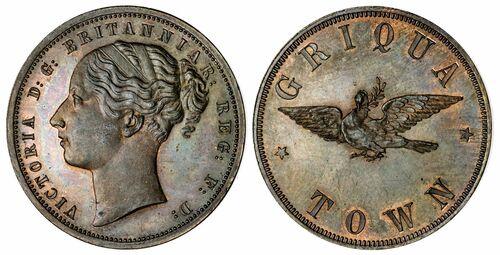
Auction: 23006 - The Official COINEX Auction at Spink
Lot: 441
The Dr Frank Becker Collection | NGC MS63 BN | South Africa, Northern Cape Province, Griekwastad [Griquatown], AE Pattern Penny, [1890], young bust left, rev. GRIQUA TOWN, dove flying left with olive branch, plain edge, 10.66g, 6h (Hern GT21), with a couple of faint contact marks to otherwise patinated and residually brilliant fields, hints of mint red with recesses, a most handsome extremely fine, rare, in NGC holder, graded NGC MS63 BN (Cert. #6767903-002)
Provenance
The Dr Frank Becker Collection of World Coins
Spink, by private treaty, 15 December 1967 - £80.0.0
Glendining, 25-26 October 1967, lot 814 - "extremely fine" - £62.0.0
Griquatown is situated in the Northern Cape Province of South Africa. The town, formerly named Klaarwater, was established in April 1805 by missionary William Anderson of the London Missionary Society.
The Griqua, a racially and culturally mixed group, descended mainly from intermarriage and sexual relationships between indigenous Khoikhoi, slave mothers and European male colonists. They referred to themselves as Bastaards amongst others.
A group of Bastaards, persuaded by the missionaries, settled at Klaarwater. During his visit to the town on 7 August 1813 John Campbell, a Director of the London Missionary Society thought the name Bastaards to be offensive. Campbell suggested they adopt the name of Griqua, a corruption of the name of their ChariGuriQua ancestors. During the same meeting the name Klaarwater was changed to Griqua Town.
Early Griquas consisting mostly of Bastaard families moved circa 1780 from the northern section of the Cape colony to settle along the Orange River. The powerful Kok and Barends families, both with a considerable following, formed the nuclei of the Griqua community. Although the Kok and Barends families probably controlled the affairs of the Griquas who settled with them, autonomous groups formed in the area. John Mellville, a missionary agent, studied these groups and noted that one of the groups increased from perhaps 3 to 4 Griqua families to over 40 between 1817 and 1823. Immigrants also settled in the area, establishing claims to fountains and pans while retaining links with the Griqua leadership. The Griquas were formidable traders who understood the concept of money, acting as middlemen between the colony and the northern nations. Formal trade took place at trade fairs arranged by the colonial government, while illegal trading with colonists was a common occurrence.
Griqua coinage was introduced to Griquatown, South Africa circa 1817-1818 by the London Missionary Society. This was the first known issue of currency by Christian missionaries in South Africa. The coinage was referred to as tokens by the London Missionary Society and was minted in four denominations: 1/4 and 1/2 pence in copper, and 5 and 10 pence in silver. At the meeting of 7 August 1813 various other issues were discussed, including coinage, where: "It was likewise resolved that as they had no circulating medium amongst them by which they could purchase any small article, such as knives, scissors, etc. supposing a shop to be established amongst them - which they were anxious there should be - they should apply to the Missionary Society to get silver pieces of different value coined for them in England, which the Missionaries would take for their allowance from the Society, having the name of Griqua town marked on them. It is probable that if this were adopted in a short time they would circulate amongst all the nations about, and be a great convenience"
Circumstances at the Cape meant a dire shortage of circulated coinage in Griquatown and surrounds. Griqua trade was done mainly by barter, beads and rixdollars. This state of affairs must have prompted John Campbell to suggest a coinage for the Griqua District.
Subject to 20% VAT on Buyer’s Premium. For more information please view Terms and Conditions for Buyers.
Sold for
£850
Starting price
£500




